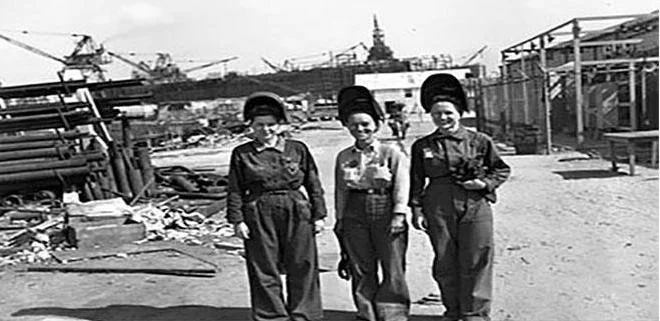Women welders at work at ADDSCO January 30, 1945. ADDSCO Collection, The Doy Leale McCall Rare Book and Manuscript Library, University of South Alabama.
Three women wielders at ADDSCO. ADDSCO Collection, The Doy Leale McCall Rare Book and Manuscript Library, University of South Alabama.
In 1940, the city of Mobile had a population of just over 78,000. But with the outbreak of World War II and the city’s rapid industrial mobilization, particularly in shipbuilding and military aviation, that number surged to an estimated 125,000 by 1943. The metropolitan area saw an even more dramatic jump, from 174,000 to 260,000, as people from across Alabama and neighboring states flocked to the Port City in search of steady, well-paying jobs. The flood of new arrivals, while economically invigorating, strained Mobile’s infrastructure, schools, and housing supply.
With over one-third of working-age men entering military service after the 1940 Selective Training and Service Act, labor shortages quickly became acute. To fill this gap, women were actively recruited to step into roles traditionally held by men, launching a major cultural and workforce shift. The War Manpower Commission ran national and local campaigns to encourage women to join the industrial labor force, appealing to both their patriotism and economic motivations. In Mobile, these efforts were especially successful.
By 1942, Brookley Field, the headquarters of the Mobile Air Service Command and Southeast Army Air Depot, had begun hiring women to work as clerks, mechanics, welders, inspectors, and technicians. Starting with just 23 women in January 1942, the number soared to 2,300 by that September. At its wartime peak in 1943, Brookley Field employed more than 17,000 civilians half of them women—making it the largest employer of women in Alabama.
Meanwhile, at Alabama Drydock and Shipbuilding Company (ADDSCO) and Gulf Shipbuilding, women took up positions as welders and riveters in Mobile’s booming shipyards. Across the city, women made up between one-quarter and one-half of all defense-related jobs. Many were attracted to the high wages, some earning as much as $3,600 a year as trained welders, a stark contrast to the $800 starting salary of a schoolteacher.
Women were often preferred for certain roles: their dexterity made them well-suited for precision tasks, such as repairing delicate aircraft instruments or working in confined ship compartments. The Fair Employment Practices Committeealso pushed for greater racial inclusivity. As a result, Brookley Field became one of the few major facilities in the South to employ Black women in skilled and semi-skilled positions, including aircraft inspection and mechanical repair.
The cultural and economic impact of this shift was enormous. For many women this was the first time they held industrial or technical jobs with decent pay and some level of workplace recognition. Although most were expected to give up their positions when the war ended, their contributions left a lasting legacy and laid the groundwork for postwar movements for workplace and gender equality.
Advertisement promoting a 1943 “women-in-war-jobs” recruitment campaign. (Mobile Press Register, February 21, 1943; courtesy of University of South Alabama Library) Mary Martha Thomas, Riveting and Rationing in Dixie: Alabama Women and the Second World War. 18
Advertisement that suggests unemployed Mobile women get jobs at vital war plants. Mobile Press Register, February 21, 1943; courtesy of University of South Alabama Library) Mary Martha Thomas, Riveting and Rationing in Dixie: Alabama Women and the Second World War. 27



